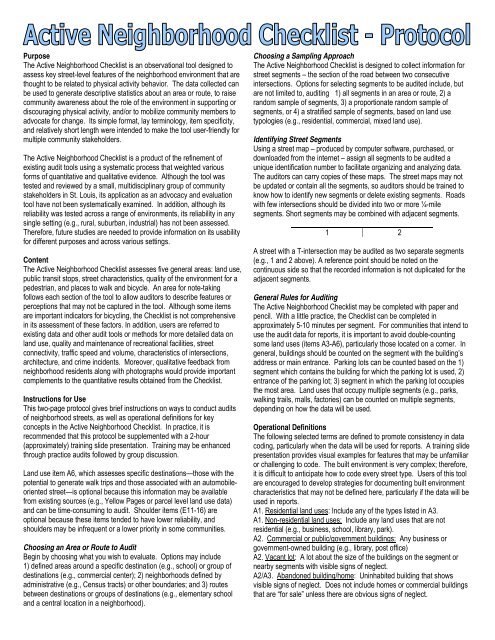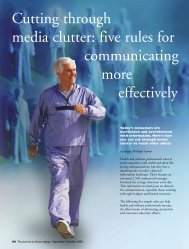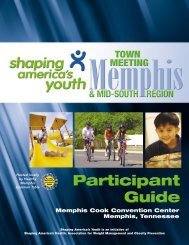Purpose The Active Neighborhood Checklist is an ... - Active for Life
Purpose The Active Neighborhood Checklist is an ... - Active for Life
Purpose The Active Neighborhood Checklist is an ... - Active for Life
Create successful ePaper yourself
Turn your PDF publications into a flip-book with our unique Google optimized e-Paper software.
<strong>Purpose</strong><br />
<strong>The</strong> <strong>Active</strong> <strong>Neighborhood</strong> <strong>Checkl<strong>is</strong>t</strong> <strong>is</strong> <strong>an</strong> observational tool designed to<br />
assess key street-level features of the neighborhood environment that are<br />
thought to be related to physical activity behavior. <strong>The</strong> data collected c<strong>an</strong><br />
be used to generate descriptive stat<strong>is</strong>tics about <strong>an</strong> area or route, to ra<strong>is</strong>e<br />
community awareness about the role of the environment in supporting or<br />
d<strong>is</strong>couraging physical activity, <strong>an</strong>d/or to mobilize community members to<br />
advocate <strong>for</strong> ch<strong>an</strong>ge. Its simple <strong>for</strong>mat, lay terminology, item specificity,<br />
<strong>an</strong>d relatively short length were intended to make the tool user-friendly <strong>for</strong><br />
multiple community stakeholders.<br />
<strong>The</strong> <strong>Active</strong> <strong>Neighborhood</strong> <strong>Checkl<strong>is</strong>t</strong> <strong>is</strong> a product of the refinement of<br />
ex<strong>is</strong>ting audit tools using a systematic process that weighted various<br />
<strong>for</strong>ms of qu<strong>an</strong>titative <strong>an</strong>d qualitative evidence. Although the tool was<br />
tested <strong>an</strong>d reviewed by a small, multid<strong>is</strong>ciplinary group of community<br />
stakeholders in St. Lou<strong>is</strong>, its application as <strong>an</strong> advocacy <strong>an</strong>d evaluation<br />
tool have not been systematically examined. In addition, although its<br />
reliability was tested across a r<strong>an</strong>ge of environments, its reliability in <strong>an</strong>y<br />
single setting (e.g., rural, suburb<strong>an</strong>, industrial) has not been assessed.<br />
<strong>The</strong>re<strong>for</strong>e, future studies are needed to provide in<strong>for</strong>mation on its usability<br />
<strong>for</strong> different purposes <strong>an</strong>d across various settings.<br />
Content<br />
<strong>The</strong> <strong>Active</strong> <strong>Neighborhood</strong> <strong>Checkl<strong>is</strong>t</strong> assesses five general areas: l<strong>an</strong>d use,<br />
public tr<strong>an</strong>sit stops, street character<strong>is</strong>tics, quality of the environment <strong>for</strong> a<br />
pedestri<strong>an</strong>, <strong>an</strong>d places to walk <strong>an</strong>d bicycle. An area <strong>for</strong> note-taking<br />
follows each section of the tool to allow auditors to describe features or<br />
perceptions that may not be captured in the tool. Although some items<br />
are import<strong>an</strong>t indicators <strong>for</strong> bicycling, the <strong>Checkl<strong>is</strong>t</strong> <strong>is</strong> not comprehensive<br />
in its assessment of these factors. In addition, users are referred to<br />
ex<strong>is</strong>ting data <strong>an</strong>d other audit tools or methods <strong>for</strong> more detailed data on<br />
l<strong>an</strong>d use, quality <strong>an</strong>d mainten<strong>an</strong>ce of recreational facilities, street<br />
connectivity, traffic speed <strong>an</strong>d volume, character<strong>is</strong>tics of intersections,<br />
architecture, <strong>an</strong>d crime incidents. Moreover, qualitative feedback from<br />
neighborhood residents along with photographs would provide import<strong>an</strong>t<br />
complements to the qu<strong>an</strong>titative results obtained from the <strong>Checkl<strong>is</strong>t</strong>.<br />
Instructions <strong>for</strong> Use<br />
Th<strong>is</strong> two-page protocol gives brief instructions on ways to conduct audits<br />
of neighborhood streets, as well as operational definitions <strong>for</strong> key<br />
concepts in the <strong>Active</strong> <strong>Neighborhood</strong> <strong>Checkl<strong>is</strong>t</strong>. In practice, it <strong>is</strong><br />
recommended that th<strong>is</strong> protocol be supplemented with a 2-hour<br />
(approximately) training slide presentation. Training may be enh<strong>an</strong>ced<br />
through practice audits followed by group d<strong>is</strong>cussion.<br />
L<strong>an</strong>d use item A6, which assesses specific destinations—those with the<br />
potential to generate walk trips <strong>an</strong>d those associated with <strong>an</strong> automobileoriented<br />
street—<strong>is</strong> optional because th<strong>is</strong> in<strong>for</strong>mation may be available<br />
from ex<strong>is</strong>ting sources (e.g., Yellow Pages or parcel level l<strong>an</strong>d use data)<br />
<strong>an</strong>d c<strong>an</strong> be time-consuming to audit. Shoulder items (E11-16) are<br />
optional because these items tended to have lower reliability, <strong>an</strong>d<br />
shoulders may be infrequent or a lower priority in some communities.<br />
Choosing <strong>an</strong> Area or Route to Audit<br />
Begin by choosing what you w<strong>is</strong>h to evaluate. Options may include<br />
1) defined areas around a specific destination (e.g., school) or group of<br />
destinations (e.g., commercial center); 2) neighborhoods defined by<br />
admin<strong>is</strong>trative (e.g., Census tracts) or other boundaries; <strong>an</strong>d 3) routes<br />
between destinations or groups of destinations (e.g., elementary school<br />
<strong>an</strong>d a central location in a neighborhood).<br />
Choosing a Sampling Approach<br />
<strong>The</strong> <strong>Active</strong> <strong>Neighborhood</strong> <strong>Checkl<strong>is</strong>t</strong> <strong>is</strong> designed to collect in<strong>for</strong>mation <strong>for</strong><br />
street segments – the section of the road between two consecutive<br />
intersections. Options <strong>for</strong> selecting segments to be audited include, but<br />
are not limited to, auditing 1) all segments in <strong>an</strong> area or route, 2) a<br />
r<strong>an</strong>dom sample of segments, 3) a proportionate r<strong>an</strong>dom sample of<br />
segments, or 4) a stratified sample of segments, based on l<strong>an</strong>d use<br />
typologies (e.g., residential, commercial, mixed l<strong>an</strong>d use).<br />
Identifying Street Segments<br />
Using a street map – produced by computer software, purchased, or<br />
downloaded from the internet – assign all segments to be audited a<br />
unique identification number to facilitate org<strong>an</strong>izing <strong>an</strong>d <strong>an</strong>alyzing data.<br />
<strong>The</strong> auditors c<strong>an</strong> carry copies of these maps. <strong>The</strong> street maps may not<br />
be updated or contain all the segments, so auditors should be trained to<br />
know how to identify new segments or delete ex<strong>is</strong>ting segments. Roads<br />
with few intersections should be divided into two or more ¼-mile<br />
segments. Short segments may be combined with adjacent segments.<br />
1 2<br />
A street with a T-intersection may be audited as two separate segments<br />
(e.g., 1 <strong>an</strong>d 2 above). A reference point should be noted on the<br />
continuous side so that the recorded in<strong>for</strong>mation <strong>is</strong> not duplicated <strong>for</strong> the<br />
adjacent segments.<br />
General Rules <strong>for</strong> Auditing<br />
<strong>The</strong> <strong>Active</strong> <strong>Neighborhood</strong> <strong>Checkl<strong>is</strong>t</strong> may be completed with paper <strong>an</strong>d<br />
pencil. With a little practice, the <strong>Checkl<strong>is</strong>t</strong> c<strong>an</strong> be completed in<br />
approximately 5-10 minutes per segment. For communities that intend to<br />
use the audit data <strong>for</strong> reports, it <strong>is</strong> import<strong>an</strong>t to avoid double-counting<br />
some l<strong>an</strong>d uses (items A3-A6), particularly those located on a corner. In<br />
general, buildings should be counted on the segment with the building’s<br />
address or main entr<strong>an</strong>ce. Parking lots c<strong>an</strong> be counted based on the 1)<br />
segment which contains the building <strong>for</strong> which the parking lot <strong>is</strong> used, 2)<br />
entr<strong>an</strong>ce of the parking lot; 3) segment in which the parking lot occupies<br />
the most area. L<strong>an</strong>d uses that occupy multiple segments (e.g., parks,<br />
walking trails, malls, factories) c<strong>an</strong> be counted on multiple segments,<br />
depending on how the data will be used.<br />
Operational Definitions<br />
<strong>The</strong> following selected terms are defined to promote cons<strong>is</strong>tency in data<br />
coding, particularly when the data will be used <strong>for</strong> reports. A training slide<br />
presentation provides v<strong>is</strong>ual examples <strong>for</strong> features that may be unfamiliar<br />
or challenging to code. <strong>The</strong> built environment <strong>is</strong> very complex; there<strong>for</strong>e,<br />
it <strong>is</strong> difficult to <strong>an</strong>ticipate how to code every street type. Users of th<strong>is</strong> tool<br />
are encouraged to develop strategies <strong>for</strong> documenting built environment<br />
character<strong>is</strong>tics that may not be defined here, particularly if the data will be<br />
used in reports.<br />
A1. Residential l<strong>an</strong>d uses: Include <strong>an</strong>y of the types l<strong>is</strong>ted in A3.<br />
A1. Non-residential l<strong>an</strong>d uses: Include <strong>an</strong>y l<strong>an</strong>d uses that are not<br />
residential (e.g., business, school, library, park).<br />
A2. Commercial or public/government buildings: Any business or<br />
government-owned building (e.g., library, post office)<br />
A2. Vac<strong>an</strong>t lot: A lot about the size of the buildings on the segment or<br />
nearby segments with v<strong>is</strong>ible signs of neglect.<br />
A2/A3. Ab<strong>an</strong>doned building/home: Uninhabited building that shows<br />
v<strong>is</strong>ible signs of neglect. Does not include homes or commercial buildings<br />
that are “<strong>for</strong> sale” unless there are obvious signs of neglect.
A2. Undeveloped l<strong>an</strong>d: Large area of natural space that <strong>is</strong> not maintained<br />
by public or private entities.<br />
A2. Designated green space: Large area of natural space that <strong>is</strong><br />
maintained by public or private entities <strong>an</strong>d open to the public.<br />
A5.Off-road walking/biking trail: Off-road sidewalk or trail (including<br />
sidewalks around parks) that people walk or bike on primarily <strong>for</strong> exerc<strong>is</strong>e<br />
or le<strong>is</strong>ure.<br />
A6. Indoor fitness centers: Examples include yoga, pilates, d<strong>an</strong>ce, <strong>an</strong>d<br />
martial arts studios, public recreation centers, <strong>an</strong>d indoor tenn<strong>is</strong> clubs.<br />
A6. Big box store: Large, rect<strong>an</strong>gular commercial buildings, typically with<br />
st<strong>an</strong>dardized facades, large parking lots, <strong>an</strong>d facing major traffic arterials.<br />
Examples include Walmart, Office Depot, Best Buy, <strong>an</strong>d Home Depot.<br />
A6. Strip mall: Commercial centers with attached units arr<strong>an</strong>ged in a row,<br />
typically denoted by a sign. Th<strong>is</strong> <strong>is</strong> <strong>an</strong> indicator of <strong>an</strong> auto-oriented street<br />
so it should not be selected <strong>for</strong> all connected commercial units.<br />
A. L<strong>an</strong>d use notes: Note major natural l<strong>an</strong>dscape features (e.g., lakes,<br />
rivers), major barriers (e.g., railroad tracks, highway), or other d<strong>is</strong>tinct l<strong>an</strong>d<br />
use character<strong>is</strong>tics or destinations.<br />
B. Tr<strong>an</strong>sit stop notes: Note the condition of a tr<strong>an</strong>sit stop.<br />
C2. Special speed zones: Speed limit signs <strong>for</strong> special situations, such as<br />
school zones, construction zones, or sharp turns in the roadway.<br />
C3. Total # of l<strong>an</strong>es: Number of l<strong>an</strong>es (including unmarked l<strong>an</strong>es) <strong>for</strong><br />
traffic. Excludes the turning l<strong>an</strong>e <strong>an</strong>d parking l<strong>an</strong>es<br />
C5. Medi<strong>an</strong> or pedestri<strong>an</strong> <strong>is</strong>l<strong>an</strong>d: Ra<strong>is</strong>ed <strong>is</strong>l<strong>an</strong>d or refuge <strong>for</strong> pedestri<strong>an</strong>s<br />
between traffic l<strong>an</strong>es. May take up all or part of the segment. Extremely<br />
narrow medi<strong>an</strong>s or medi<strong>an</strong>s with so much l<strong>an</strong>dscaping as to prevent<br />
pedestri<strong>an</strong>s from using them should not be counted.<br />
C6. Turn l<strong>an</strong>e: Only count turn l<strong>an</strong>es that occupy a l<strong>an</strong>e <strong>for</strong> the entire<br />
length of the roadway.<br />
C7. Crosswalk: Denoted by painted white line(s), flashing light(s), <strong>an</strong>d/or<br />
pedestri<strong>an</strong> crossing sign(s)<br />
C9. Traffic calming device: Device intentionally designed to reduce traffic<br />
speed or volume, such as a roundabout, brick road, speed hump, flashing<br />
speed sign, or “watch <strong>for</strong> children” sign. Curb bulb-outs (technically<br />
crossing aids) are areas of the sidewalk/curb that extend into the street,<br />
mostly at intersections, to shorten pedestri<strong>an</strong> crossing d<strong>is</strong>t<strong>an</strong>ces.<br />
C10a. Sidewalk cut-through: Sidewalk or path that connects a cul-de-sac<br />
to a nearby street or greenbelt without permitting passage of automobiles.<br />
C. Street character<strong>is</strong>tic notes: Note street character<strong>is</strong>tics that may<br />
influence a pedestri<strong>an</strong>’s or bicycl<strong>is</strong>t’s feelings of com<strong>for</strong>t <strong>an</strong>d safety from<br />
traffic, such as perceived traffic volume <strong>an</strong>d speed, aggressive drivers,<br />
<strong>an</strong>d condition of crossing aids <strong>an</strong>d medi<strong>an</strong>s.<br />
D1. Commercial buildings adjacent to the sidewalk: Building that c<strong>an</strong> be<br />
entered directly from the sidewalk along the street without crossing a<br />
parking lot. If no sidewalk <strong>is</strong> present, check “no.”<br />
D2a. Bench: Includes public benches along the sidewalk, not in a park.<br />
D2b. Drinking fountain: If the drinking fountain <strong>is</strong> not functional, then do<br />
not count it <strong>an</strong>d note its condition in the notes section.<br />
D3. Public art: Statues, sculptures, fountains, or murals. May include<br />
b<strong>an</strong>ners if they st<strong>an</strong>d out <strong>an</strong>d enh<strong>an</strong>ce the aesthetic quality of the street.<br />
Excludes artwork placed in the windows of commercial buildings or<br />
associated with residential buildings (e.g., yard art, private fountains).<br />
D5. Litter or broken glass: When evaluating the amount of litter <strong>an</strong>d<br />
broken glass, imagine <strong>an</strong> immaculate street <strong>an</strong>d heavily littered street <strong>for</strong><br />
relative compar<strong>is</strong>ons with the street being audited.<br />
D6. Tree shade along the walking area: Evaluate tree shade that would<br />
cover the sidewalk or other walking area at approximately noon. During<br />
months when trees are without leaves, env<strong>is</strong>ion what shade the trees<br />
might provide with leaves. Shade provided by buildings should not be<br />
counted here. As with litter <strong>an</strong>d broken glass, consider the extremes.<br />
D7. Steepest slope along the walking area: Compare the slope along the<br />
segment to a street with a flat slope <strong>an</strong>d a steep slope. A flat/gentle slope<br />
would hardly be noticeable to most individuals. A moderate slope would<br />
not act as a barrier to most individuals but walking on it may increase<br />
some individuals’ heart rates. A steep slope would act as a barrier to<br />
individuals who are not active or with physical limitations.<br />
D. Pedestri<strong>an</strong> environment notes: Note d<strong>is</strong>tinct features that enh<strong>an</strong>ce or<br />
detract from a pedestri<strong>an</strong>’s walking experience.<br />
E2. Any grassy or other buffer between curb <strong>an</strong>d sidewalk along most of<br />
the segment: A buffer includes grass, trees, flowerpots, <strong>an</strong>d/or textured<br />
sidewalk that provides separation between pedestri<strong>an</strong>s <strong>an</strong>d traffic.<br />
E2a. Tree(s) in buffer: Trees provide a buffer from traffic <strong>for</strong> pedestri<strong>an</strong>s,<br />
as well as aesthetic appeal.<br />
E3. Sidewalks continuous within segment: <strong>The</strong>re are no interruptions<br />
(other th<strong>an</strong> driveways) in the sidewalk within a single segment.<br />
E4. Sidewalks continuous between segments at both ends: <strong>The</strong> sidewalk<br />
continues in one or more directions beyond the segment audited. Th<strong>is</strong><br />
must be true <strong>for</strong> both ends of the segment.<br />
E5. Width ≥ 5 ft <strong>for</strong> most of the segment: Width c<strong>an</strong> be determined by<br />
estimating or by measuring each auditor’s foot prior to auditing to<br />
determine how m<strong>an</strong>y “auditor’s feet” would equal 5 feet. In rare cases<br />
when parking lots <strong>an</strong>d sidewalks are juxtaposed, do not count the parking<br />
lot when measuring the width of the sidewalk.<br />
E6. Width < 3 ft <strong>for</strong> <strong>an</strong>y part of the sidewalk: By estimating or using<br />
auditor’s measured foot (see E5), determine if the walking area <strong>is</strong> less<br />
th<strong>an</strong> 3 feet <strong>for</strong> <strong>an</strong>y part of the sidewalk. <strong>The</strong> width may be
Date:<br />
Auditor ID:<br />
Street Name:<br />
Start Time:<br />
Segment ID:<br />
<strong>Neighborhood</strong> ID:<br />
Is <strong>an</strong>y building or section of the sidewalk or roadway under<br />
construction or being repaired?<br />
Yes, specify: _________________________________________<br />
No<br />
A. What l<strong>an</strong>d uses are present?<br />
1. Are residential <strong>an</strong>d non-residential l<strong>an</strong>d uses present?<br />
All residential<br />
Both residential <strong>an</strong>d non-residential<br />
All non-residential<br />
2. What <strong>is</strong> the predomin<strong>an</strong>t l<strong>an</strong>d use?<br />
Check one or two that apply.<br />
Residential buildings/yards<br />
Commercial or public/government buildings<br />
School/school yards (elementary, middle, high school)<br />
Parking lots or garages<br />
Park with exerc<strong>is</strong>e/sport facilities or playground equipment<br />
Vac<strong>an</strong>t lot/ab<strong>an</strong>doned building<br />
Undeveloped l<strong>an</strong>d<br />
Designated green space<br />
Other non-residential, specify: __________________________<br />
3. What types of residential uses are present?<br />
Select all that apply.<br />
None<br />
Ab<strong>an</strong>doned homes<br />
Single family homes<br />
Multi-unit homes (2-4 units)<br />
Apartments or condominiums (>4 units, 1-4 stories)<br />
Apartments or condominiums (>4 stories)<br />
Apartment over retail<br />
Other (retirement home, mobile home, dorms)<br />
5. What public recreational facilities <strong>an</strong>d equipment are present<br />
(including in the schoolyard if publicly accessible)?<br />
Select all that apply.<br />
Park with exerc<strong>is</strong>e/sport facilities or playground equipment<br />
Off-road walking/biking trail<br />
Sports/playing field<br />
Basketball/tenn<strong>is</strong>/volleyball court<br />
Playground<br />
Outdoor pool<br />
Other: _________________________________________<br />
6. (OPTIONAL) What types of non-residential uses are present?<br />
Select all that apply.<br />
None<br />
Ab<strong>an</strong>doned building<br />
Specific types of destinations:<br />
Small grocery, convenience store (including in gas station), or<br />
pharmacy<br />
Food establ<strong>is</strong>hment (restaur<strong>an</strong>t, bakery, café, coffee shop, bar)<br />
Entertainment (e.g., movie theatre, arcade)<br />
Library or post office<br />
B<strong>an</strong>k<br />
Laundry/dry cle<strong>an</strong>er<br />
Indoor fitness facility<br />
Educational facilities:<br />
School (elementary, middle, high school)<br />
College, technical school, or university<br />
Large buildings housing 1+ businesses/services:<br />
High-r<strong>is</strong>e building (>5 stories)<br />
Big box store (e.g., Walmart, Office Depot, Best Buy)<br />
Mall<br />
Strip mall<br />
Supermarket<br />
Large office building, warehouse, factory, or industrial building<br />
L<strong>an</strong>d use notes:<br />
4. What parking facilities are present?<br />
Select all that apply.<br />
None (no parking allowed on street at <strong>an</strong>y time)<br />
On-street, including <strong>an</strong>gled parking<br />
Small lot or garage (
B. Is public tr<strong>an</strong>sportation available? E. Do you have a place to walk or bicycle?<br />
No<br />
1. Any tr<strong>an</strong>sit stop (bus, train, or other)? go to C1<br />
1a. Bench or covered shelter at<br />
tr<strong>an</strong>sit stop?<br />
Tr<strong>an</strong>sit stop notes:<br />
Yes,<br />
one<br />
side<br />
C. What street character<strong>is</strong>tics are v<strong>is</strong>ible?<br />
1. Enter posted speed limit (99 if none):<br />
2. Enter special speed zone (99 if none):<br />
3. Enter total # of l<strong>an</strong>es on street:<br />
4. Marked l<strong>an</strong>es?<br />
5. Medi<strong>an</strong> or pedestri<strong>an</strong> <strong>is</strong>l<strong>an</strong>d?<br />
6. Turn l<strong>an</strong>e?<br />
7. Crosswalk <strong>for</strong> crossing th<strong>is</strong> segment?<br />
8. “Walk” / “Don’t Walk” signal?<br />
9. Traffic calming device (roundabout, curb<br />
bulb-outs, speed bump, brick road, other)?<br />
No<br />
10. Cul-de-sac (dead-end street)? go to D1<br />
10a. Sidewalk cut-through in cul-de-sac?<br />
Street character<strong>is</strong>tic notes:<br />
Yes,<br />
both<br />
sides<br />
Yes<br />
If yes, specify type(s):<br />
No<br />
SIDEWALKS<br />
1. Sidewalk present? go to E10<br />
2. Any grassy or other buffer between go to E3<br />
curb <strong>an</strong>d sidewalk along most of the<br />
segment?<br />
2a. Tree(s) in buffer?<br />
3. Sidewalk continuous within segment?<br />
4. Sidewalk continuous between<br />
segments at both ends?<br />
5. Width ≥5 ft <strong>for</strong> most of the sidewalk?<br />
6. Width





